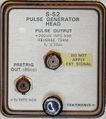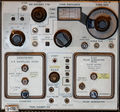S-52: Difference between revisions
(same board names as in schematic) |
(links, better pics) |
||
| Line 2: | Line 2: | ||
title=Tektronix S-52 | | title=Tektronix S-52 | | ||
summary=Pulse Generator | | summary=Pulse Generator | | ||
image= | image=Tek-s52-front.jpg | | ||
caption=S-52 head | | caption=S-52 head, front panel | | ||
series=[[:Category:Sampling plugins|7000/S3 series Sampling Plugins]] | | series=[[:Category:Sampling plugins|7000/S3 series Sampling Plugins]] | | ||
years=? – ? | | years=? – ? | | ||
| Line 18: | Line 18: | ||
In addition to the main pulse output, the S-52 also produces a pre-trigger pulse 85 ns before the main pulse. | In addition to the main pulse output, the S-52 also produces a pre-trigger pulse 85 ns before the main pulse. | ||
The jitter between the pre-trigger pulse and the main pulse is specified as less than 10 ps. | The delay is generated with a digital counter, and jitter between the pre-trigger pulse and the main pulse is specified as less than 10 ps. The pre-trigger pulse uses a [[Connectors#BSM|BSM connector]]. | ||
The pre-trigger pulse uses a [[Connectors#BSM|BSM connector]]. | |||
The S-52 generates the main output pulse using a 50 mA low-capacitance [[tunnel diodes|tunnel diode]] with part number [[153-0400-00]]. | The S-52 generates the main output pulse using a 50 mA low-capacitance [[tunnel diodes|tunnel diode]] with part number [[153-0400-00]]. | ||
The S-52 is [[S-50#Comparison_of_S-50_and_S-52|similar to the S-50]], but the S-50 has twice the pulse amplitude. | The S-52 is [[S-50#Comparison_of_S-50_and_S-52|similar to the S-50]], but the S-50 has twice the pulse amplitude. | ||
The reason for this is that the S-52 has a 48 Ω resistor between the output tunnel diode and the output connector providing back termination, | The reason for this is that the S-52 has a 48 Ω resistor between the output tunnel diode and the output connector providing back termination, while the S-50 has no such resistor. Although the S-52 produces a smaller pulse, its output impedance is much better controlled than that of the S-50, and the output resistor may also provide some limited protection for the output tunnel diode. | ||
while the S-50 has no such resistor. Although the S-52 produces a smaller pulse, its output impedance is much better controlled than that of the S-50, and the output resistor may also provide some limited protection for the output tunnel diode. | |||
==Specifications== | ==Specifications== | ||
| Line 31: | Line 30: | ||
{{Spec | Rise time | < 25 ps}} | {{Spec | Rise time | < 25 ps}} | ||
{{Spec | Output amplitude | 200 mV into 50 Ω (SMA)}} | {{Spec | Output amplitude | 200 mV into 50 Ω (SMA)}} | ||
{{Spec | Output impedance | 50 Ω | {{Spec | Output impedance | 50 Ω «reverse terminated» (i.e. having controlled source impedance) }} | ||
{{Spec | Pre-trigger output | 85 ns before main pulse (jitter < 10 ps), +1 V into 50 Ω (BSM) }} | {{Spec | Pre-trigger output | 85 ns before main pulse (jitter < 10 ps), +1 V into 50 Ω (BSM) }} | ||
{{EndSpecs}} | {{EndSpecs}} | ||
==Links== | |||
* [http://www.amplifier.cd/Test_Equipment/Tektronix/Tektronix_7000_series_special/S-52.html Tek S-52 page @ amplifier.cd] | |||
* http://www.barrytech.com/tektronix/tek7000/teks52.html | |||
==Pictures== | ==Pictures== | ||
<gallery> | <gallery> | ||
File:Tek s52.jpg | File:Tek-s52-front.jpg | S-52 front | ||
File: | File:7s12-s6-s52-f.jpg | S-52 pulse generator and [[S-6|S-6 sampling head]] in a [[7S12|7S12 TDR/Sampler plugin]] | ||
File:Tek-s52-1.jpg | A1 Timing board (right) | </gallery> | ||
File:Tek-s52-2.jpg | A3 Trigger board (left) | |||
File:Tek-s52-3.jpg | A2 Tunnel Diode Control board (center) | ===Internal=== | ||
File:Tek-s52-4.jpg | Tunnel diode mount | <gallery> | ||
File:Tek-s52-1.jpg | A1 Timing board (right) | |||
File:Tek-s52-2.jpg | A3 Trigger board (left) | |||
File:Tek-s52-3.jpg | A2 Tunnel Diode Control board (center) | |||
File:Tek-s52-4.jpg | Tunnel diode mount | |||
File:Tek-s52-diode-mount.jpg | Tunnel diode mount, detail | File:Tek-s52-diode-mount.jpg | Tunnel diode mount, detail | ||
File:Tek_s-52_schem2.png |Schematic | File:Tek_s-52_schem2.png |Schematic | ||
</gallery> | |||
===Measurements=== | |||
<gallery> | |||
File:7s12-s52-incident.jpg | [[7S12]] displaying the incident pulse from an S-52 (nom. < 25 ps) through an [[S-6]] head (nom. < 30 ps). | File:7s12-s52-incident.jpg | [[7S12]] displaying the incident pulse from an S-52 (nom. < 25 ps) through an [[S-6]] head (nom. < 30 ps). | ||
</gallery> | </gallery> | ||
[[Category:7000 and 3S series sampling heads]] | [[Category:7000 and 3S series sampling heads]] | ||
Revision as of 07:30, 17 July 2014
The Tektronix S-52 is a pulse generator head compatible with S-series sampling units
like the 3S2, 7S11, and 7S12.
It puts out a 200 mV pulse into a load of 50 Ω. The pulse has a rise time of 25 ps or less. The output is an SMA connector.
In addition to the main pulse output, the S-52 also produces a pre-trigger pulse 85 ns before the main pulse. The delay is generated with a digital counter, and jitter between the pre-trigger pulse and the main pulse is specified as less than 10 ps. The pre-trigger pulse uses a BSM connector.
The S-52 generates the main output pulse using a 50 mA low-capacitance tunnel diode with part number 153-0400-00.
The S-52 is similar to the S-50, but the S-50 has twice the pulse amplitude. The reason for this is that the S-52 has a 48 Ω resistor between the output tunnel diode and the output connector providing back termination, while the S-50 has no such resistor. Although the S-52 produces a smaller pulse, its output impedance is much better controlled than that of the S-50, and the output resistor may also provide some limited protection for the output tunnel diode.
Specifications
Key Specifications
| Rise time | < 25 ps |
|---|---|
| Output amplitude | 200 mV into 50 Ω (SMA) |
| Output impedance | 50 Ω «reverse terminated» (i.e. having controlled source impedance) |
| Pre-trigger output | 85 ns before main pulse (jitter < 10 ps), +1 V into 50 Ω (BSM) |
Links
Pictures
-
S-52 front
-
S-52 pulse generator and S-6 sampling head in a 7S12 TDR/Sampler plugin
Internal
-
A1 Timing board (right)
-
A3 Trigger board (left)
-
A2 Tunnel Diode Control board (center)
-
Tunnel diode mount
-
Tunnel diode mount, detail
-
Schematic









